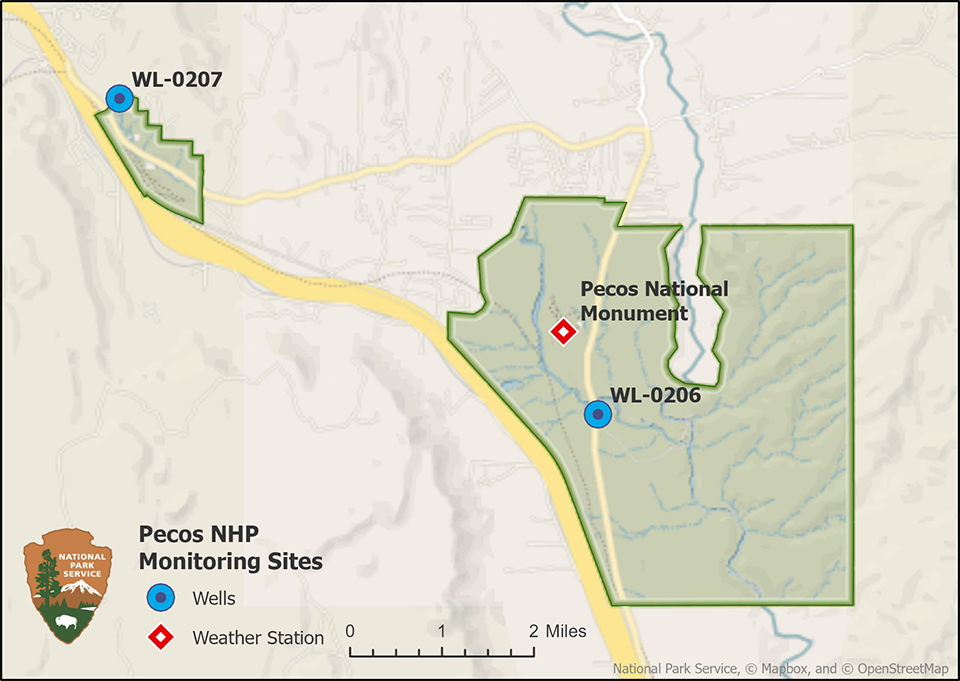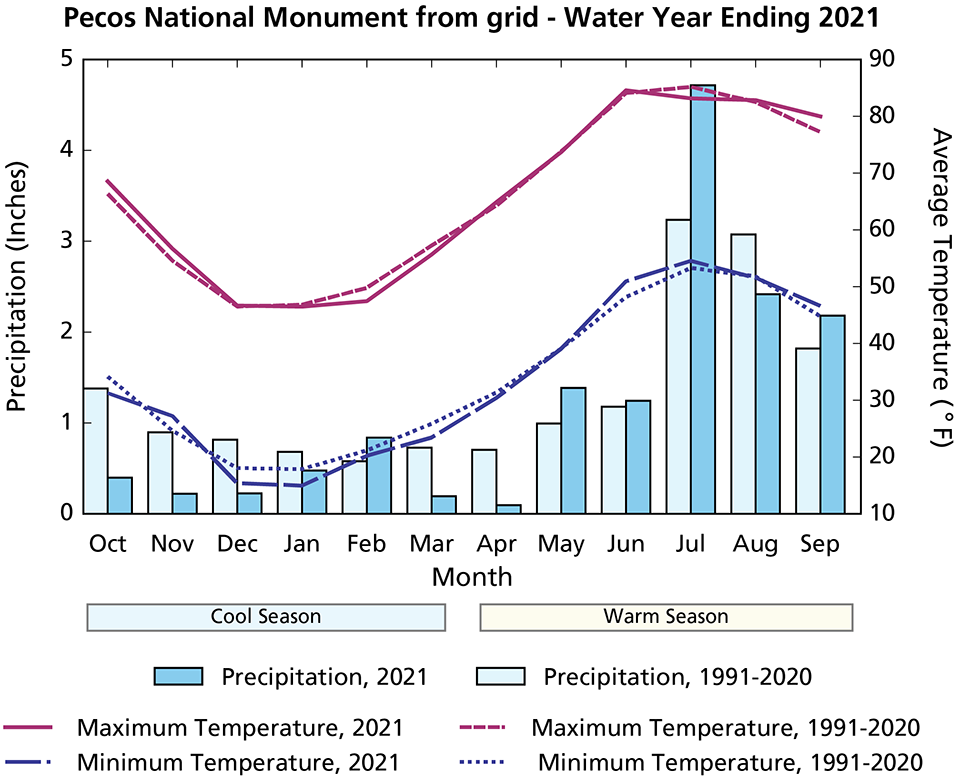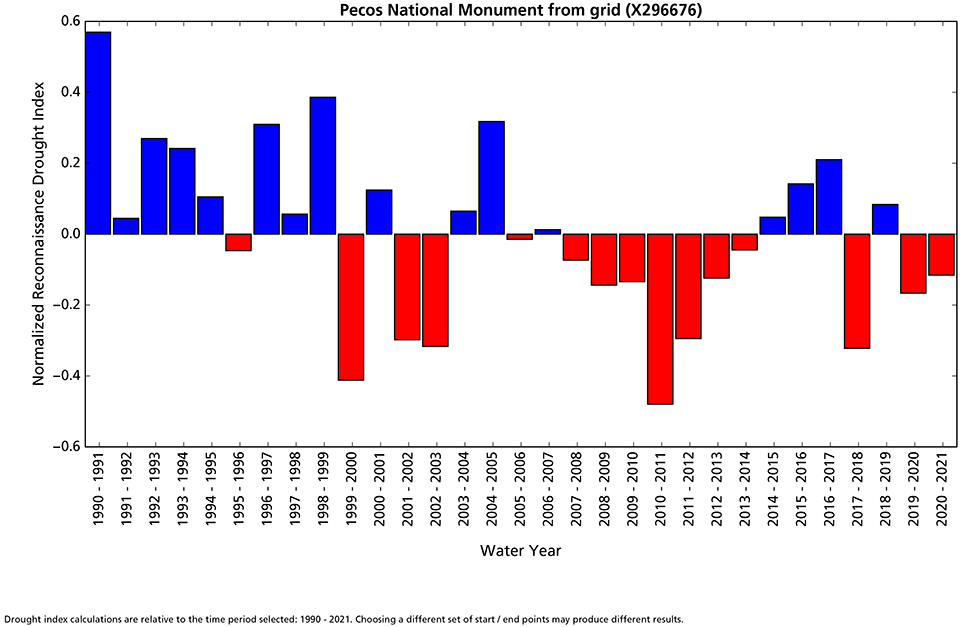Last updated: April 3, 2024
Article
Climate and Water Monitoring at Pecos National Historical Park

NPS
Overview
Together, climate and hydrology shape ecosystems and the services they provide, particularly in arid and semi-arid places. Understanding changes in climate, groundwater, and surface water is key to assessing the condition of park natural resources—and often, cultural resources.
At Pecos National Historical Park, our Southern Plains Inventory and Monitoring Network scientists study how ecosystems may be changing by taking measurements of key resources or “vital signs” year after year, much as a doctor keeps track of a patient's vital signs. This long-term ecological monitoring provides early warning of potential problems, allowing managers to mitigate them before they become worse. We monitor climate, weather, and groundwater, among other vital signs at the park.
Groundwater conditions are closely related to climate conditions. Because they are better understood together, we report on climate in conjunction with water resources. Reporting is by water year (WY), which begins in October of the previous calendar year and goes through September of the water year (e.g., WY2021 runs October 2020 through September 2021).
This article reports the results of climate and water monitoring done at Pecos National Historical Park in water year 2021.

NPS
Climate and Weather
There is often confusion over the terms, “weather” and “climate.” In short, weather describes instantaneous meteorological conditions (e.g., it's currently raining or snowing, it's a hot or frigid day). Climate reflects patterns of weather at a given place over longer periods of time (seasons to years). Climate is the primary driver of ecological processes on Earth. Climate and weather information provide context for understanding the status or condition of other park resources.
Methods
Since 1916, Pecos National Historical Park has operated a National Oceanic and Atmospheric Administration Cooperative Observer Program (NOAA COOP) weather station (Pecos National Monument #296676; Figure 1). This station typically provides a reliable, long-term climate dataset; however, in WY2021 it was missing data on 135 days. As a substitute, all analyses for this report use gridded surface meterological (GRIDMET) data from the station location for this water year and for the 30-year averages. Subsequent reports may revert back to the NOAA COOP weather station data depending on future data quality.
GRIDMET is a spatial climate dataset at a 4-km resolution that is interpolated using weather station data, topography, and other observational and modeled land surface data. GRIDMET estimated temperature and precipitation may vary from actual weather at a particular location because of the availability of weather station data and the difference in elevation at the location and elevation assigned to a grid cell. Data from both the weather station and GRIDMET are accessible through Climate Analyzer.

NPS
Recent Findings
Precipitation
Annual precipitation at Pecos National Historical Park in WY2021 was 14.39" (36.6 cm; Figure 2), 1.65" (4.2 cm) less than the 1991–2020 average. This deficit occurred primarily in the cool season (October–March), which received only 2.35" (6.0 cm), less than half of the 1991–2020 average. Precipitation in the warm season (April–September) totaled 12.04" (30.6 cm), 1.06" (2.7 cm) more than the 1991–2020 average for those months.
Air Temperature
The average annual air temperatures in WY2021 were similar to the 1991–2020 averages. The average annual maximum air temperature in WY2021 was 66.0°F (18.9°C), which was similar to the 1991–2020 average. The average annual minimum air temperature in WY2021 was 33.9°F (1.1°C), only 0.4°F (0.2°C) cooler than the 1991–2020 average. The WY2021 average monthly maximum and minimum temperatures were within 3.0°F (1.7°C) of the 1991–2020 averages for the entire year.

GRIDMET/Climateanalyzer.org
Drought
Reconnaissance drought index (Tsakiris and Vangelis 2005) provides a measure of drought severity and extent relative to the long-term climate. It is based on the ratio of average precipitation to average potential evapotranspiration (water loss due to evaporation and plant transpiration if water supply is not limited) over short periods of time (seasons to years). The reconnaissance drought index for Pecos National Historical Park indicates WY2021 was slightly drier than the 1991–2021 average from the perspective of both precipitation and potential evapotranspiration (Figure 3).
Reference: Tsakiris G., and H. Vangelis. 2005. Establishing a drought index incorporating evapotranspiration. European Water 9: 3–11.

GRIDMET/Climateanalyzer.org

NPS
Groundwater
Groundwater is one of the most critical natural resources of the American Southwest, providing drinking water, irrigating crops, and sustaining rivers, streams, and springs throughout the region.
MethodsPecos National Historical Park groundwater is monitored in two wells (Figure 4). The New Mexico Bureau of Geology and Mineral Resources began monitoring both wells in 2020. The well at the trading post (WL-0206) is monitored continuously and the well at the Glorieta Battlefield Trail (WL-0207) is monitored annually. The data are available at the Healy Collaborative Groundwater Monitoring Network.
Recent Findings
Groundwater levels in WY2021 were stable and relatively shallow (Table 1 and Figure 4). The average depth to water at WL-0206 for the period of continuous monitoring (17 December 2020–26 August 2021) was 41.27 ft below ground surface (bgs); however, this includes measurements recorded when the well was pumping or recently pumped, causing temporary decreases in water level of up to 20 feet. The WL-0206 static water level was likely slightly higher. Water level in WL-0207 was only 0.09 ft lower than the previous measurement made in WY2020.
Table 1. Groundwater monitoring results in water year 2021, Pecos National Historical Park (amsl = above mean sea level; bgs = below ground surface). *The WY2020 water level measurements at WL-0206 were collected when the well was pumped recently and do not represent static water level measurements.
| State Well Number | Location | Wellhead Elevation (ft amsl) | Mean Depth to Water (ft bgs) | Mean Water Level Elevation (ft amsl) | Change in Elevation from Water Year 2020 (± ft) |
|---|---|---|---|---|---|
| WL-0206 | Trading post | 6833.00 | 41.27 | 6,791.73 | Not applicable* |
| WL-0207 | Glorieta Battlefield Trail | 7330.00 | 34.09 | 7,295.91 | −0.09 |

NPS
